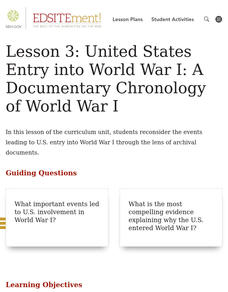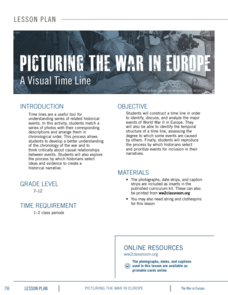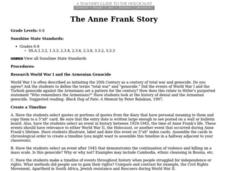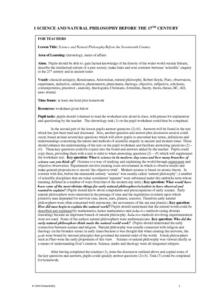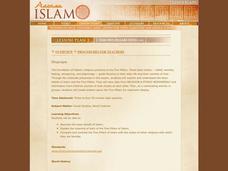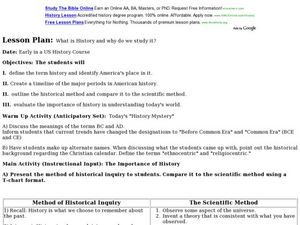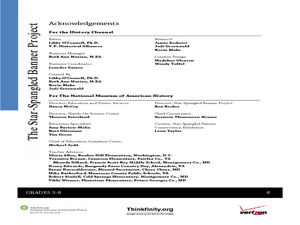Curated OER
World History: Chronology
Students examine periods of time throughout world history. For this time chronology lesson plan, students read and create time lines. Students complete a variety of activities involving the ordering of events in time.
Curated OER
United States Entry into World War I: A Documentary Chronology of World War I
Students identify several important events that led to U.S. involvement in World War I. They examine different explanations, form an opinion about the evidence for each rationale and then create a slideshow to present their findings.
Curated OER
Lesson Plan on Making a World History Timeline
Fifth graders examine and discuss the concept of chronological order. They research an assigned continent and construct a chronological timeline using a list of historic events.
Curated OER
United States Entry into World War I: A Documentary Chronology of World War I
Eleventh graders reconsider the events leading to U.S. entry into World War I through the lens of archival documents.
National WWII Museum
Picturing the War in Europe: A Visual Time Line
Where does it fit in history? Learners consider the choices historians make when evaluating events by constructing a timeline of World War II. Using photographs of events in the conflict, they create a chronology. Once finished,...
Curated OER
The Anne Frank Story
What is genocide? Create timelines regarding the human genocide. Middle and high schoolers analyze information that requires them to consider links between Armenian genocide and the Holocaust. In groups, theydesign timelines that...
Curated OER
The Cuneiform Writing System in Ancient Mesopotamia: Emergence and Evolution
Students research the parallel development and complexity of writing and civilization in ancient Mesopotamia. For this ancient Mesopotamia lesson, students analyze the Cuneiform writing system in ancient Mesopotamia and how the...
Curated OER
Science and Natural Philosophy Before the Seventeenth Century
Students complete a worksheet about some of the natural philosophers in history. They use graph paper and create a timeline with the dates of birth and names of a list of natural philosophers. They list four questions concerning life and...
Constitutional Rights Foundation
Special Order 40
The city of Los Angeles' 1979 Special Order 40 states: "LAPD officers shall not initiate police action with the objective of discovering the alien status of a person." After reading a fact sheet that details the history of Special Order...
Curated OER
Can You Hear Me Now?
Young scholars explore the industry involving communication and put communication devices into activities. For this communication lesson plan, students put items into chronological order, review primary sources, compare and contrast...
Curated OER
The Five Pillars of Islam
In order to better understand Muslim civilization, culture, and politics one must first familiarize themselves on the 5 Pillars of Islam, ideas which dominate much of Muslim societal and cultural norms. Provide your learners with a...
Curated OER
Eyewitness to History
Students explore historical connections, talking with family members about landmark events they have witnessed in their lifetimes to explore how history touches our lives. They identify several landmark events of the late 20th century.
Foreign Policy Research Institute
Ancient and Medieval China
This is a thorough lesson on Chinese history that includes readings from primary and secondary sources, guided reading questions, videos, and a take-home final assessment. While it indicates an audience from 9th through 12th grade, it...
American Chemical Society
Man and Materials Through History
From the start of the Industrial Revolution, it only took 147 years for someone to invent plastic. This may seem like a long time, but in the history of inventing or discovering new materials, this is incredibly fast. An informative and...
Curated OER
What is History and Why Do We Study It?
Students examine why it is important to study American history. In this American history lesson, students discuss why it is necessary to study history, arrange an outline of American history events in chronological order, and write...
Curated OER
Pre History through Modern Day Timeline
Students explore the historical sequence of cultures throughout history. They demonstrate the ability to organize events in chronological order and demonstrate how time is measured and annotated.
Curated OER
A History of the War of 1812 and The Star-Spangled Banner
Students examine the causes and outcomes of the War of 1812, and determine the chronology of the Star-Spangled Banner. In this War of 1812 lesson plan, students learn vocabulary and read a narrative about the War of 1812 before...
Curated OER
Class, At-ten-tion!
Students explore alphabetical and chronological organization through geography. In this lesson on ancient India, students use computers to create and publish autobiographical time lines to illustrate important events in their lives....
Curated OER
Building an Art History Timeline
Middle schoolers cooperatively make a timeline on the wall that uses biographies of artists and images of their work in chronological order.
Curated OER
Timeline - United States and Germany, Before, During, and After World War II
Students read novel Rosa's Miracle Mouse, research assigned years in small groups, and create timelines and Powerpoint presentations detailing interaction between Germany and the United States before, during, and after World War II.
Curated OER
The Road to World War II
Students research the orgins and early events of World War II using online and off line resources. They conduct an interview with a local World War II veteral and present their findings to the class.
Curated OER
Life and Times, Developing a Chronology
Students review the career and life of Ernie Pyle as an example of a biography in context. They consider how a chronology maps out the events in the life of an individual in the context of other events that were occurring at the same time.
Curated OER
The Aztecs - Mighty Warriors of Mexico
Upper elementary learners identify the Aztecs as the builders of a great city and rich civilization in what is now Mexico. They locate the Aztec Empire and its capital on a map and place the Aztecs in the chronology of American history....
Curated OER
Man's Search For Meaning: Concept Analysis
Designed as a resource for teachers who use Man's Search for Meaning, this seven-page packet includes a list of related informational texts, research issues and project ideas, central questions, background information on World...





